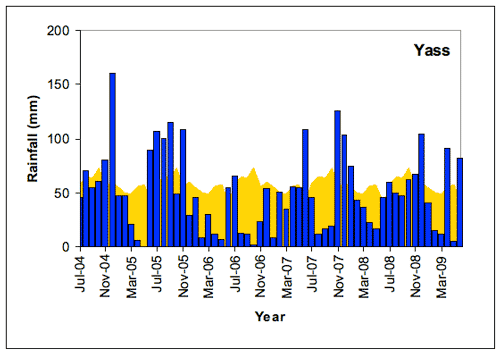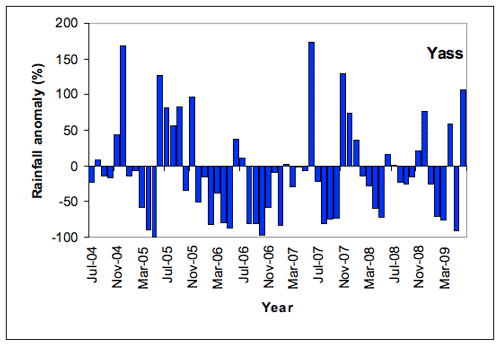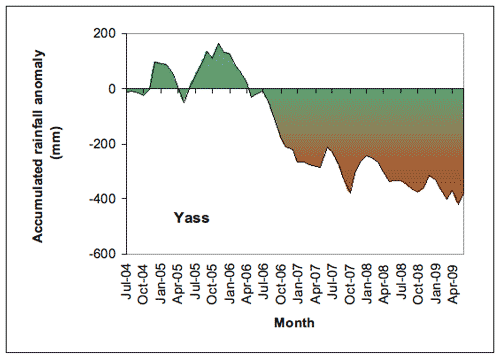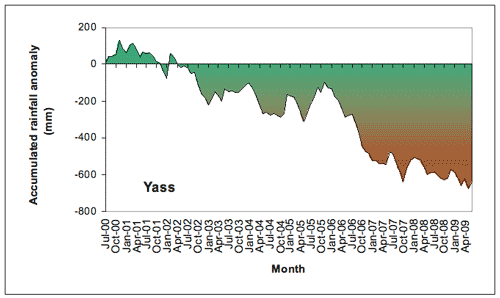Yass Valley
Please note: Text or data highlighted in this colour represent an update to this indicator for the period 2008/09. All rainfall figures have been updated on this page.
Rainfall Analysis
The main rainfall observing site used in this analysis was Yass – Linton Hostel (Bureau of Meteorology Station No. 070091), which has records commencing in 1898. Data from nearby stations were used to calculate values for months with missing data at this site (see Appendix 2 for further information).
Note that in the following analyses rainfall totals for individual months or years (where the year is defined as the 12 months from July to June) are compared to the long-term average (or climatology) from 1961-1990. A 30-year period is used to calculate climatological averages to conform with World Meteorological Organisation practice; this takes into account year-to-year variations and less frequent events such as El Niño or La Niña. This particular 30-year period is used internationally as a standard climatological average period.
As shown in the table below, Yass had below average rainfall in two of the four years 2004/5 to 2008/9 and close to average in two years. The driest year was 2006/7, when rainfall was 29.4% below average. The wettest year in the last four years was 2004/5 when rainfall was 680.7 mm, which was almost average.
| Rainfall Statistics | Yass | ||||
|---|---|---|---|---|---|
2004/5 |
2005/6 |
2006/7 |
2007/8 |
2008/9 |
|
| Annual Total* (mm) | 680.7 |
667.6 |
481.8 |
567.8 |
635.5 |
| Anomaly (mm) | -1.3 |
-14.4 |
-200.2 |
-114.2 |
-46.5 |
| Anomaly (%) | -0.2 |
-2.1 |
-29.4 |
-16.7 |
-6.8 |
| Mean (1961-1990) (mm) | 682.0 |
||||
*Note: annual totals were calculated for the 12 months July-June.
Monthly Rainfall, 2004-2009
A comparison of monthly rainfall totals with the long-term monthly average rainfall at Yass (Figure 1) shows generally below average rainfall over the period with several short periods of above average rainfall. The prolonged dry period from December 2005 to March 2007 reflects the impact of the El Niño event that occurred during 2006/7. Other shorter periods of below average conditions occurred during autumn 2005, August to October 2007 and autumn 2008. The above average rainfall in the period November 2007 to January 2007 was a result of the development of a La Niña event as was rainfall in November-December 2008. The only lengthy period of above average rainfall occurred in the period May to November 2005. After an above average November-December 2008, Yass experienced a dry January-March 2009.
 |
Of the 60 months in this period, there were 39 months (65% of the record) with below average rainfall at Yass (Figure 3). The most prolonged dry spell in the region began in December 2005 and extended to March 2007. During this period there were only four months of near average or above average rainfall. The autumns of 2005, 2008 and 2009 were also very dry periods. The driest individual month was May 2005 with 0.2 mm (long term average for May is 57.5 mm) while October 2006 only recorded 2 mm and May 2009 only 5mm. Generally average rainfall occurred during August 2004 to February 2005, April to June 2007 and October-December 2008 while above average rainfall occurred during June to November 2005 and November 2007 to January 2008. The wettest month was December 2004 with 159.8 mm (long term average for December is 59.4 mm) while November 2007 recorded 126.2 mm. This December rainfall was the third wettest December on record since 1898 and possibly since 1882 while the November total was likely to be the seventh wettest November for these periods.
 |
The results of the generally below-average rainfall conditions at Yass during this five year period are reflected in the accumulated rainfall deficits (Figure 4). Accumulated monthly rainfall totals were generally positive up to early 2006 when there was a rapid increase in the rainfall deficit which extended less rapidly into 2007 when it then fluctuated around that level through late 2007 to 2009. The rapid drop during 2006 reflects the dry conditions due to the impact of the El Niño event during 2006/7. The total accumulated deficit for the period was of 380.2 mm which represents 57% of the average Jul-Jun annual rainfall.
 |
The climatological context for rainfall at Yass
The long-term perspective
As is typical of the region, Yass has experienced large fluctuations in annual (July-June) rainfall, including several extended periods of above- or below-average rainfall since records began in 1899. In general, annual rainfall was lower and less variable early in the 20th century, followed by a period of greater variability. Rainfall variability has been lower since about 1980 (Figure 4). The recent dry period is reflected in other parts of the long term record such as late 19th to the early part of the 20th Century and the period from the late 1920’s through to the end of World War 2. To this point in time this recent dry period can only be considered as part of the long term variability in rainfall experienced in the region.
- Rainfall in the late 19th and early 20th century at Yass was generally below average (to about 1950), with the notable exception of a short wet period in the 1930s. Since then annual rainfall totals have been more variable.
- Several wetter-than-normal years around 1950 and 1960 produced a generally wetter period then; the same is true of the mid 1970s.
- A drier period around 1980 was followed by slightly above-average rainfall until the early 1990s. Since 1998 conditions have been generally drier than average.
The wettest year (July-June) on record at Yass was 1955/6 (1221 mm); the driest year was 1918/9 (333 mm).
![Figure 4. Annual (July-June) rainfall at Yass from 1882/3 to 2008/9 depicted as deviations from the long-term mean. A 5-year running mean is superimposed to highlight wetter and drier periods. [Deviations were calculated as the difference between the rainfall for each year and the mean for the period 1961-1990 (scale in mm).]](../images/yassvalley/rain04.gif) |
The long term monthly rainfall anomaly accumulation since 2000 (Figure 5) shows positive values until 2002, when negative rainfall anomalies led to an accumulation deficit. Rainfall accumulation stabilised during 2003, increased slightly in 2004, and declined again in 2005. The dry conditions in 2006 led to another rapid increase in the accumulation of a deficit during 2006. This record reflects the impacts of the two El Niño years of 2002/03 and 2006/07.During the whole period there were 67 months (62%) of rainfall deficit with the total accumulated deficit of 636.1 mm (92 % of the average Jul-Jun rainfall) over this nine year period.
 |
About the data
